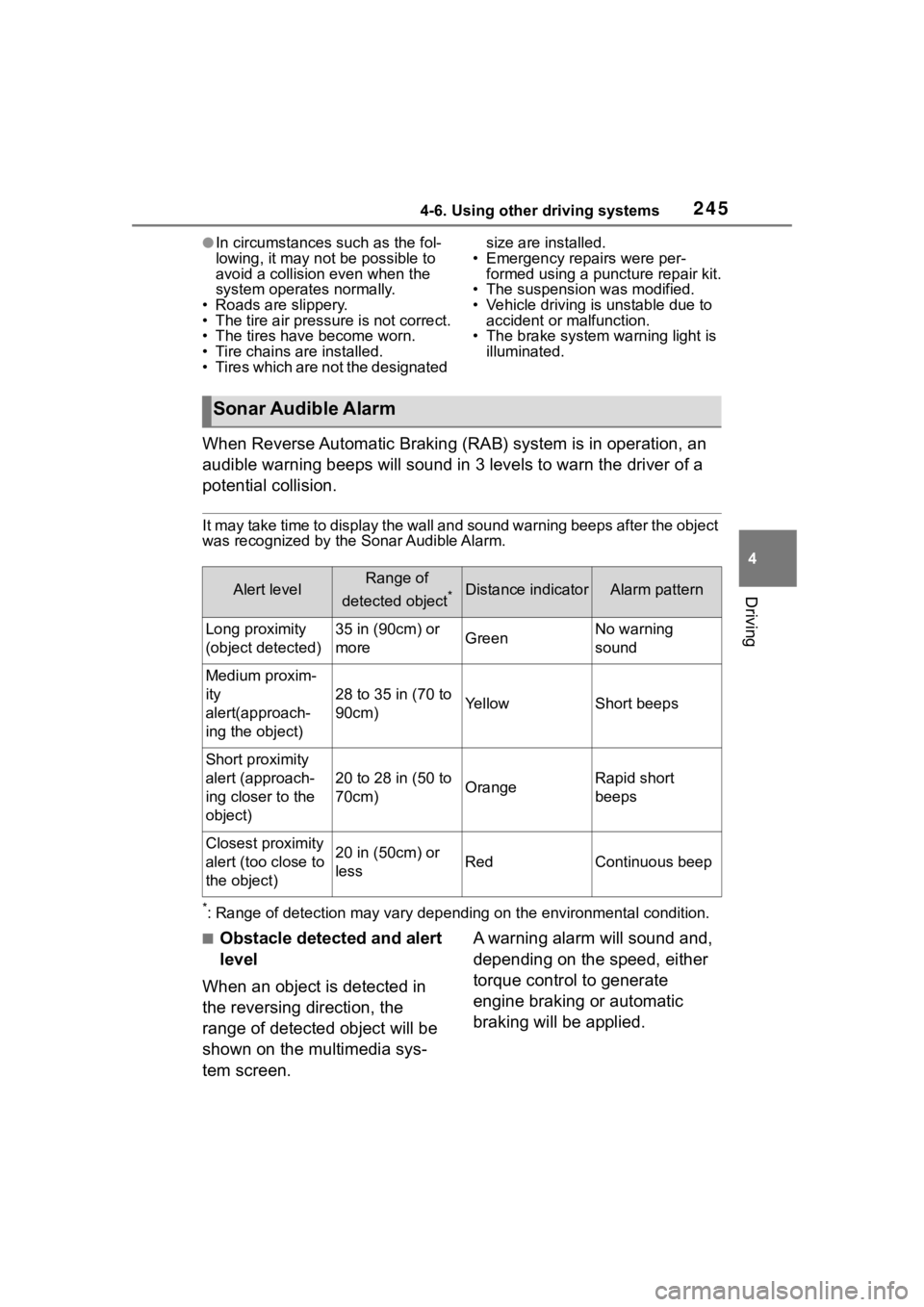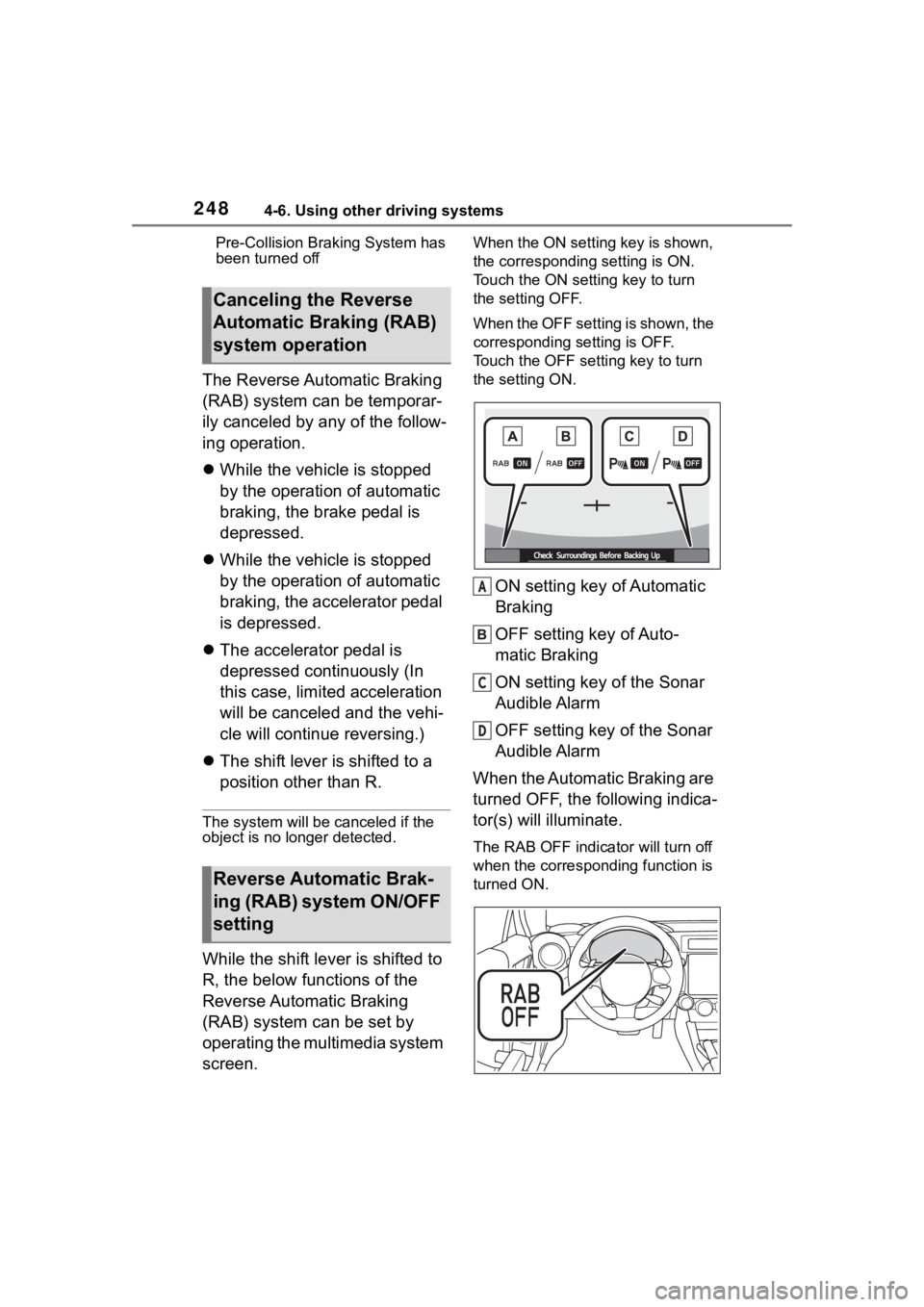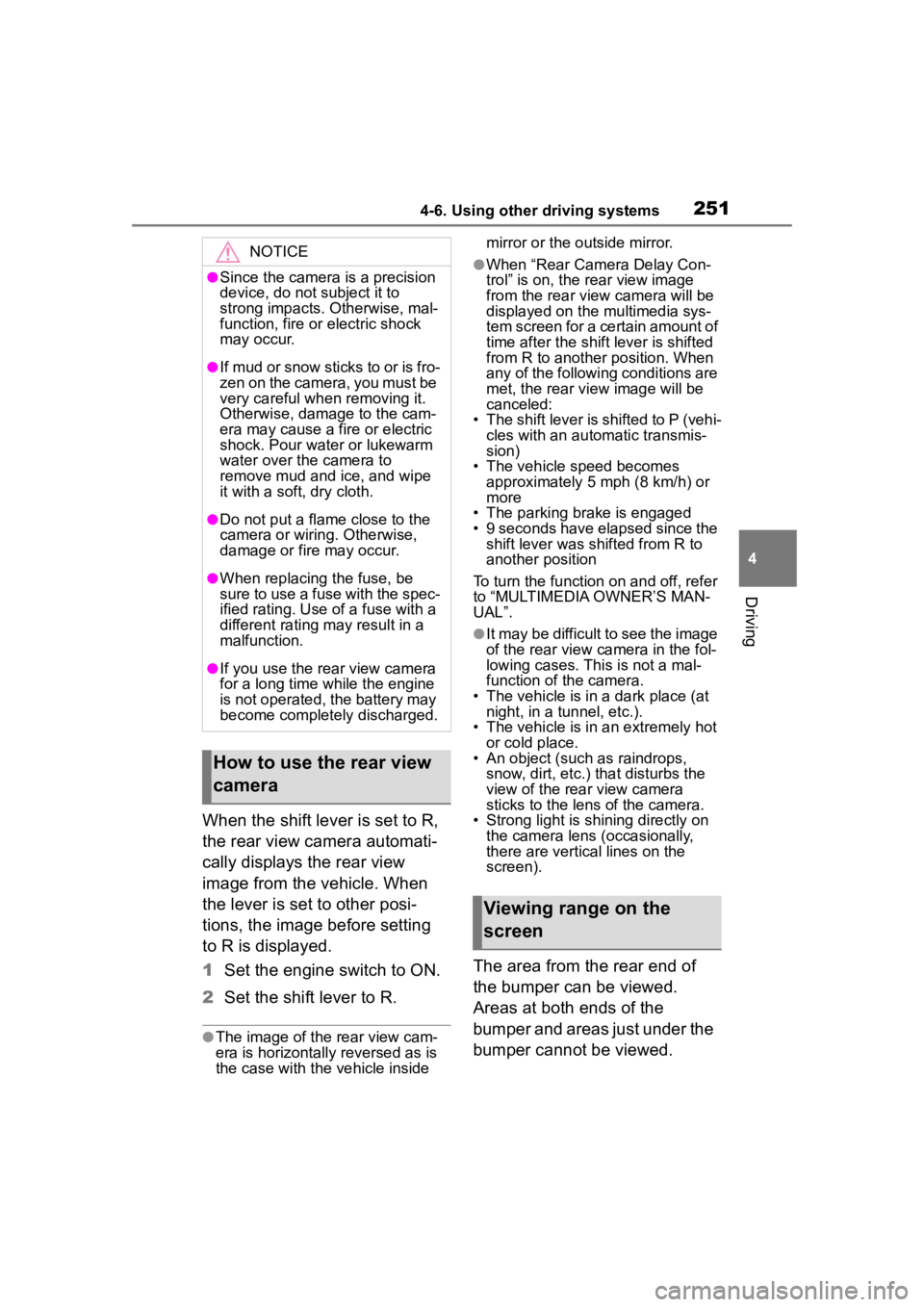2023 TOYOTA 86 brake
[x] Cancel search: brakePage 240 of 449

2404-6. Using other driving systems
*: If equipped
The Reverse Automatic Braking
(RAB) system records and stores
the following data when automatic
braking operates. It does not record
conversations, personal information
or other audio data.
●Distance from the object
●Vehicle speed
●Accelerator pedal operation status
●Brake pedal operation status
●Shift lever position
●Outside temperature
●The sensitivity setting of the sonar
sensors
Toyota and third parties contracted
by Toyota may acquire and use the
recorded data for the purpose of
vehicle research and development.
Toyota and third parties contracted
by Toyota will not disclose or pro-
vide the acquired data to any other
third party except under the follow-
ing conditions.
●The vehicle owner has given
his/her consent.
●The disclosure/prov ision is based
NOTICE
●Always keep the bumper sur-
face near the radar sensors
clean.
●Do not affix any stickers or other
items on the bumper surface
near the radar sensors. For
details, consult your Toyota
dealer.
●Do not modify the bumper near
the radar sensors.
●Do not paint the bumper near
the radar sensors.
●Do not expose the bumper near
the radar sensors to strong
impacts. If a sensor becomes
misaligned, a system malfunc-
tion may occur, including the
inability to detect vehicles enter-
ing the detection areas. If any
strong shock is applied to the
bumper, be sure to contact your
Toyota dealer for inspection.
●Do not disassemble the radar
sensors.
Reverse Automatic
Braking (RAB) system*
Reverse Automatic Braking
(RAB) is a system designed
to help avoid collisions or
reduce collision damage
when reversing the vehicle.
If a wall or an obstacle is
detected in the reversing
direction, the system will
notify the driver with a
warning sound and may
activate the vehicle’s brakes
automatically.
Page 241 of 449

2414-6. Using other driving systems
4
Driving
on a court order or other legally
enforceable request.
●Data that has been modified so
that the user and vehicle cannot
be identified is provided to a
research institution for statistical
processing or similar purposes.
The Reverse Automatic Braking
(RAB) system will operate the
following 2 functions using 4
sonar sensors.
Sonar Audible Alarm
The Reverse Automatic Braking
(RAB) system detects objects rear-
ward and warns the driver by warn-
ing message on the multimedia
system screen an d warning beeps.
Automatic Braking
The automatic braking detects
objects rearward and if there is a
high risk of a co llision, the system
decelerates the vehicle and con-
trols the braking to reduce damage.
When reversing
When either strong automatic
braking or torque control is
applied to prevent collision (in
WARNING
●Reverse Automatic Braking
(RAB) is not a system intended
to replace the driver’s responsi-
bility to check their surroundings
for vehicles or obstacles to
avoid a collision.
●The driver is responsible for
driving safely. Before reversing,
be sure to first depress the
brake pedal and visually check
the surroundings.
●There are some cases in which
the vehicle cannot avoid colli-
sion, because the system oper-
ation has limitations. The
warning sound or automatic
braking may be delayed or may
not operate at all even when an
obstacle is present.
●Make sure to set the Automatic
Braking to OFF when the vehi-
cle is on the free roller or on the
chassis dynamometer. Other-
wise, the vehicle may move and
it may cause an accident.
●Make sure to set the Automatic
Braking to OFF when towing the
vehicle. Otherwise, the vehicle
may move and it may cause an
accident.
●The system is not designed to
detect people (including chil-
dren), animals or other moving
objects.
●Depending on the vehicle condi-
tion or the surrounding environ-
ment, the sonar sensor’s ability
to detect objects may become
unstable.
Reverse Automatic Brak-
ing (RAB) system over-
view
Page 242 of 449

2424-6. Using other driving systems
this case, short warning
beeps or continuous warning
beeps will sound)“Object Close Behind”
When the vehicle is stopped
by the system (in this case,
the continuous beep will
remain sounding)“Apply Brake To Hold Posi-
tion”
The Reverse Automatic Braking
(RAB) system will operate when
all of the following conditions are met.
The engine switch is in ON.
The EyeSight warning light is
off.
The RAB warning light is off.
The RAB OFF indicator is off.
The shift lever is in the R.
EyeSight warning light
RAB warning light
RAB OFF indicator
Sonar Audible Alarm
The Sonar Audible Alarm is
set to “ON”.
The vehicle speed is from 0 to
9 mph (0 to 15 km/h).
Automatic Braking
The Automatic Braking is set
to “ON”.
The vehicle speed is from 1 to
9 mph (1.5 to 15 km/h).
●In the following cases, the
Reverse Automatic Braking (RAB)
system will not oper ate. Promptly
contact a Toyota dealer to have
the system inspected.
• The EyeSight warning light is illu- minated.
• The RAB warning light is illumi-
WARNING
If your vehicle is trapped on a rail-
road crossing and you are trying
to escape by reve rsing through
the crossing gate, the system may
recognize the crossing gate as an
obstacle and brake may activate.
In this case, rem ain calm and
either continue to depress the
accelerator pedal or cancel the
system. ( P.248)
Operating conditions
A
A
A
C
Page 243 of 449

2434-6. Using other driving systems
4
Driving
nated.
●In the following cases, the
Reverse Automatic Braking (RAB)
system cannot be operated.
• The RAB OFF indicator is illumi-
nated.
●In the following cases, the func-
tions may not be able to properly
work. Promptly contact a Toyota
dealer to have the system
inspected.
• A sticker, paint, or a chemical is applied to the sonar sensors or
the rear bumper near the sonar
sensor.
• The rear bumper is modified.
• The rear bumper has been
removed and attached.
• The ground clearance is changed
due to the vehicle’s loading condi-
tion or modification.
• There is damage to the sonar sen-
sors or the rear bumper near the
sonar sensor.
• The rear bumper is exposed to
strong impact, or the rear bumper
is deformed.
●On a steep hill, t he system’s auto-
matic braking ability will be
reduced.
●The system is designed to avoid
collisions by automatic hard brak-
ing when the vehicle’s reversing
speed is less than approximately
3 mph (5 km/h). However, the sys-
tem does not guarantee that the
vehicle will be able to avoid colli-
sions in any situation.
●If the vehicle is reversed at an
extremely slow speed, the driver’s
operation may be prioritized. In
this case, automatic braking will
not operate.
●The system may not be able to
detect and apply the brake with
the following objects.
• Sharp or thin objects such as poles, fences and ropes which
may not reflect the sound wave
emitted from the sonar sensor.
• Objects that are t oo close to the
rear bumper when the shift lever is set to R.
• Objects with a su rface which may
not reflect the sound wave emitted
from the sonar sensor such as a
chain link fence.
●Objects the system is not
designed to detect and apply
brake.
• Pedestrians.
• Moving objects including moving vehicles.
• Objects which absorbs sound waves such as cloth or snow.
• Objects whose surface has a
diagonal angle.
• Objects that are low to the ground such as parking blocks.
• Objects that are high above the ground such as objects hanging
from above.
• Objects that are out of range of
the center of the vehicle in the
horizontal direction.
• Objects that are n ot in a vertical
direction.
• Objects which are not perpendicu-
lar to the ground.
• Objects which are not directly in the traveling direction of the vehi-
cle.
• Objects which a re uneven or
wavy.
●When reversing the vehicle, the
functions may not be able to work
properly or may cause a system
malfunction if the following condi-
tions exist.
High frequency so und from other
sources are nearby:
• Horn sound from another vehicle.
• Engine sound from other vehicles.
• Sound of an air brake.
• Vehicle detection equipment or a
sonar from another vehicle.
• A sound wave with a frequency similar to the veh icle’s system is
transmitted near by.
• A vehicle equipped with the same system is reversing toward your
reversing direction.
●Weather conditions:
• Extremely high or extremely low
Page 245 of 449

2454-6. Using other driving systems
4
Driving
●In circumstances such as the fol-
lowing, it may not be possible to
avoid a collision even when the
system operate s normally.
• Roads are slippery.
• The tire air pressure is not correct.
• The tires have become worn.
• Tire chains are installed.
• Tires which are not the designated size are installed.
• Emergency repairs were per- formed using a puncture repair kit.
• The suspension was modified.
• Vehicle driving is unstable due to accident or malfunction.
• The brake system warning light is
illuminated.
When Reverse Automatic Braking (RAB) system is in operation, an
audible warning beeps will sound in 3 levels to warn the driver of a
potential collision.
It may take time to display the wall and sound warning beeps af ter the object
was recognized by the Sonar Audible Alarm.
*: Range of detection may vary d epending on the environmental condition.
■Obstacle detected and alert
level
When an object is detected in
the reversing direction, the
range of detected object will be
shown on the multimedia sys-
tem screen. A warning alarm will sound and,
depending on the speed, either
torque control to generate
engine braking or automatic
braking will be applied.
Sonar Audible Alarm
Alert levelRange of
detected object
*Distance indicatorAlarm pattern
Long proximity
(object detected)35 in (90cm) or
moreGreenNo warning
sound
Medium proxim-
ity
alert(approach-
ing the object)
28 to 35 in (70 to
90cm)YellowShort beeps
Short proximity
alert (approach-
ing closer to the
object)
20 to 28 in (50 to
70cm)OrangeRapid short
beeps
Closest proximity
alert (too close to
the object)20 in (50cm) or
lessRedContinuous beep
Page 247 of 449

2474-6. Using other driving systems
4
Driving
Make sure to depress the brake
pedal once the vehicle has been
stopped by automatic braking.
Until the brake pedal is
depressed, a message will be
displayed on the multimedia
system screen and the continu-
ous beep will remain sounding.
At this time, a warning message
is also displayed on the
multi-information display.
Depress brake pedal warning“Apply Brake To Hold Posi-
tion”
The Sonar Audible Alarm and Auto-
matic Braking are different in opera-
tion conditions. Therefore there are
cases in which only one of these
functions will activate.
■After the vehicle is stopped
by the system
After the brake pedal is depressed, the RAB OFF indi-
cator will illuminate and the sys-
tem will temporarily stop
operating. The RAB OFF indica-
tor will turn off when the shift
lever is shifted to a position
other than R.
The system will operate again
the next time the shift lever is
shifted to R.
●The Reverse Automatic Braking
(RAB) system will be disabled in
the following situations.
• When 3 seconds pass after the vehicle is stopped
• When any door is opened
• When the RAB warning light is illu-
minated
• When the RAB OF F indicator is
illuminated
●The Reverse Automatic Braking
(RAB) system may stop operating
temporarily in the following cases
and the RAB OFF indicator will
illuminate.
• Ice, snow or mud is adhered to the sonar sensors or the rear bumper
near the sonar sensor
• Objects are too close to the rear bumper when the sh ift lever is set
to R
• The system detects sounds of a similar frequency to the RAB
sonar
• When the TRAC and VSC mode are turned off
• When in TRACK mode and the
WARNING
Depress the brake pedal immedi-
ately after the system stops the
vehicle by automatic braking.
Depending on the conditions of
the road surface and tires, the
vehicle may not remain stopped,
possibly leading to an accident.
A
Page 248 of 449

2484-6. Using other driving systems
Pre-Collision Braking System has
been turned off
The Reverse Automatic Braking
(RAB) system can be temporar-
ily canceled by any of the follow-
ing operation.
While the vehicle is stopped
by the operation of automatic
braking, the brake pedal is
depressed.
While the vehicle is stopped
by the operation of automatic
braking, the accelerator pedal
is depressed.
The accelerator pedal is
depressed continuously (In
this case, limited acceleration
will be canceled and the vehi-
cle will continue reversing.)
The shift lever is shifted to a
position other than R.
The system will be c anceled if the
object is no longer detected.
While the shift lever is shifted to
R, the below functions of the
Reverse Automatic Braking
(RAB) system can be set by
operating the multimedia system
screen.
When the ON setting key is shown,
the corresponding setting is ON.
Touch the ON setting key to turn
the setting OFF.
When the OFF setting is shown, the
corresponding setting is OFF.
Touch the OFF setting key to turn
the setting ON.
ON setting key of Automatic
Braking
OFF setting key of Auto-
matic Braking
ON setting key of the Sonar
Audible Alarm
OFF setting key of the Sonar
Audible Alarm
When the Automatic Braking are
turned OFF, the following indica-
tor(s) will illuminate.
The RAB OFF indica tor will turn off
when the corresponding function is
turned ON.
Canceling the Reverse
Automatic Braking (RAB)
system operation
Reverse Automatic Brak-
ing (RAB) system ON/OFF
setting
A
C
D
Page 251 of 449

2514-6. Using other driving systems
4
Driving
When the shift lever is set to R,
the rear view camera automati-
cally displays the rear view
image from the vehicle. When
the lever is set to other posi-
tions, the image before setting
to R is displayed.
1Set the engine switch to ON.
2 Set the shift lever to R.
●The image of the rear view cam-
era is horizontally reversed as is
the case with the vehicle inside mirror or the outside mirror.
●When “Rear Camera Delay Con-
trol” is on, the r
ear view image
from the r ear view camera will be
displayed on the multimedia sys-
tem screen for a certain amount of
time after the shift lever is shifted
from R to another position. When
any of the following conditions are
met, the rear view image will be
canceled:
• The shift lever is shifted to P (vehi- cles with an automatic transmis-
sion)
• The vehicle speed becomes approximately 5 mph (8 km/h) or
more
• The parking brake is engaged
• 9 seconds have elapsed since the shift lever was shifted from R to
another position
To turn the function on and off, refer
to “MULTIMEDIA OWNER’S MAN-
UAL”.
●It may be difficult to see the image
of the rear view camera in the fol-
lowing cases. This is not a mal-
function of the camera.
• The vehicle is in a dark place (at night, in a tunnel, etc.).
• The vehicle is in an extremely hot or cold place.
• An object (such as raindrops,
snow, dirt, etc.) that disturbs the
view of the rear view camera
sticks to the lens of the camera.
• Strong light is shining directly on the camera lens ( occasionally,
there are vertical lines on the
screen).
The area from the rear end of
the bumper can be viewed.
Areas at both ends of the
bumper and areas just under the
bumper cannot be viewed.
NOTICE
●Since the camera is a precision
device, do not subject it to
strong impacts. Otherwise, mal-
function, fire or electric shock
may occur.
●If mud or snow sticks to or is fro-
zen on the camera, you must be
very careful when removing it.
Otherwise, damage to the cam-
era may cause a fire or electric
shock. Pour water or lukewarm
water over the camera to
remove mud and ice, and wipe
it with a soft, dry cloth.
●Do not put a flame close to the
camera or wirin g. Otherwise,
damage or fire may occur.
●When replacing the fuse, be
sure to use a fuse with the spec-
ified rating. Use of a fuse with a
different rating may result in a
malfunction.
●If you use the rear view camera
for a long time while the engine
is not operated, the battery may
become completely discharged.
How to use the rear view
camera
Viewing range on the
screen